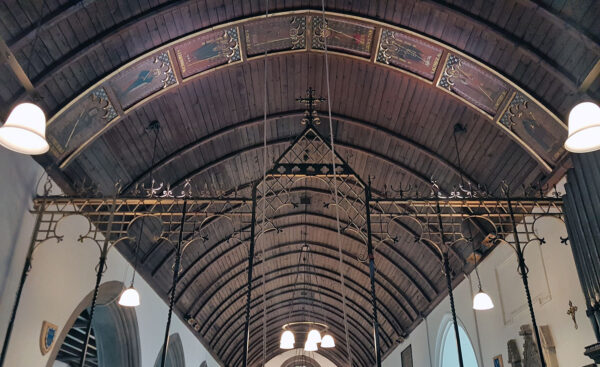Hidden behind a high wall, an ancient building in Ilford is not just the oldest building in Ilford, but one of the oldest in the entire of London.
This is the Hospital Chapel of St. Mary & St. Thomas of Canterbury, and while open weekly for worship, it’s also open occasionally for gawpers who are more interested in old buildings than bible study.
The chapel was built when everything was fields, and owned by the Abbey of Barking, an exceptionally important institution just down the road.
The chapel and almshouses were built in circa AD1145 to provide accommodation for 13 old and infirm men. Thirteen for the last supper, it is thought, as a lot of almshouses also housed 13 people at the time, which if not a biblical reference is a remarkable coincidence.
It was also home to three priests, which seems a lot, but as it was funded by the nearby Abbey, which was full of nuns, they needed local priests to do their male-only priestly duties that nuns were barred from doing.
It’s thought that the hospital (as in hospitality) became an actual hospital in the 13th and 14th centuries when it housed lepers. Under Statutes made for it by the Bishop of London in 1346 there was to be provision for “13 leprous brethren” at the homes.
Later it somehow survived Henry VIII’s wrath and was sold to various people and eventually ended up owned by the Marquesses of Salisbury who only handed it over to a charity as recently as 1982, although the Diocese of Chelmsford initially refused to take it off him unless he added an endowment of £60,000 to cover maintenance costs.
After all these centuries of private prayer and charity, it’s now occasionally open to the public.
Passing through the ancient walls and look at those old almshouses. Actually you wont — for take a closer look at the drains, and you’ll spy a very modern date on them.
In 1927, the road outside was widened, and they decided to knock down the old wall and the old almshouses and build a new one a few metres in. While heritage sacrilege, the people living in the old homes were probably quite pleased with their new indoor toilets and decent rooms.
The high wall is also from the same time, as it used to be a low church wall, with a Lych gate in front. So the almshouses were open to be seen, unlike today where they are hidden behind a high wall and locked door.
The chapel though, is fully original, baring the changes of the centuries, mostly Victorian “improvements”.
It’s made up of two aisles, with the smaller lady chapel and aisle being Victorian additions to the south side of the church. The Northern side is structurally the original 12th century chapel, as shown by the thickness of the wall and some recent discoveries.
A bricked up window at the back is from the 12th century Norman wall, and recently uncovered when works were being done on the chapel to replace poor quality Victorian concrete with more suitable lime mortar.
The rood screen has some fine metal tridents at the top, that are actually Victorian gas lamps, which did a very good job to spreading enough soot over the ceiling to cover up the painting above. The band of paintings being of Anglo-Saxon saints.
The reredos are also Victorian, and do notice in the corner, Judas sneaking off with his bag of money.
Underneath the chapel is the crypt with 85 lead lined coffins – and not open to the public.
On open days, there’s a few stalls selling bric-a-brac for the chapel charity, and at the back tea and ham rolls, with plenty of space to sit down. Local volunteers can either hand out a book of facts, or give you a very in-depth tour of the chapel, including the many and curious stained glass windows.
It’s a place worth a visit – not just one of the oldest buildings in greater London, but historically interesting in its own right, and quite pretty inside as well.
The chapel is generally open on the second Saturday in the month during the spring/summer months – check their website for dates as sometimes they’re cancelled at short notice.
Entry is free, donations welcomed.















Please proof-read your articles before publishing…there are so many spelling, grammar and lay-out errors in this single, short story that it’s laughable and begins to detract from the content.
Thank you for your comment, I have corrected the one small error that was found in the article – “with a the smaller lady chapel”.
Ilford’s oldest building.
The west aisle window is by Edward Burne.
Love church windows of all eras.